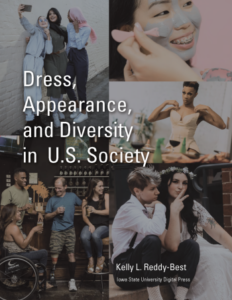Collaboration for Success: The Development Process for Dress, Appearance, and Diversity in U.S. Society
by Abbey K. Elder, Open Access and Scholarly Communication Librarian, Iowa State University; Harrison W. Inefuku, Scholarly Publishing Services Librarian, Iowa State University; Kelly L. Reddy-Best, Professor of Apparel, Merchandising and Design, Iowa State University; Lesya Hassall, Senior Manager of Instructional Design, Iowa State University

The Iowa State University Digital Press supports the publication of open access journals, conference proceedings, books, and textbooks that reflect the academic and research programs in place at Iowa State University. Iowa State University has adopted a collaborative approach to creating open educational resources, partnering with faculty, instructional designers, and other professionals across campus. Dress, Appearance, and Diversity in U.S. Society is an open textbook that was collaboratively developed between the Iowa State University Digital Press, Iowa State University’s Center for Excellence in Learning & Teaching (CELT), and Dr. Kelly L. Reddy-Best, Professor of Apparel, Merchandising, and Design, the lead author and instructor for the textbook’s corresponding course.
Recognizing the opportunity
Dress, Appearance, and Diversity in U.S. Society began as a series of loosely connected course modules housed in Canvas, Iowa State University’s learning management system. The content within these modules included presentation slides, lecture notes, and links to external readings that Dr. Kelly Reddy-Best had compiled over years of teaching. However, Dr. Reddy-Best noticed that the organization and presentation of this content was not as comprehensive or engaging for students as it could be. After applying for and receiving an institutional grant to redevelop her course materials as an open textbook, she collaborated with CELT and the Digital Press to revise her content for publication.
Aligning and revising course materials
The first step of this project was alignment. Working with Lesya Hassall, an instructional designer in CELT, Dr. Reddy-Best was able to review her course modules and identify areas where material could be improved for learners. They started by mapping the course’s content against the learning objectives that students were expected to meet. In this process, they found that some objectives were more heavily emphasized than others, requiring that either the modules or the learning objectives be adjusted accordingly. In some cases, learning objectives were rewritten or removed entirely.
Reviewing alignment in this way helped the author better understand the shape of her course and what it was emphasizing. The ensuing realignment not only helped students connect the course’s material to what they were expected to learn, but also emphasized the core concepts that Dr. Reddy-Best had added to her course since the original learning objectives were written. During this stage, the author also incorporated additional videos and contextual overviews for topics that might be culturally or socially foreign to some learners. Finally, Dr. Reddy-Best approached the Iowa State University Digital Press to prepare and publish her revised content as an open textbook.
Leveraging library expertise
 Abbey Elder, the Open Access & Scholarly Communication Librarian at Iowa State University, worked with Dr. Reddy-Best to prepare her revised modules for import into the Digital Press’ open textbook publishing software, Pressbooks. This included training the author on how to organize content for import and highlighting the unique features of Pressbooks as a platform.
Abbey Elder, the Open Access & Scholarly Communication Librarian at Iowa State University, worked with Dr. Reddy-Best to prepare her revised modules for import into the Digital Press’ open textbook publishing software, Pressbooks. This included training the author on how to organize content for import and highlighting the unique features of Pressbooks as a platform.
One of these features is the integration of H5P, an interactive third party plug-in which allows authors to create and embed interactive exercises to help readers review and reflect on the content they learn. After completing the realignment and review of her course’s modules, Dr. Reddy-Best had identified areas where her text could benefit from additional opportunities for interaction. Using this as a base, Abbey helped the instructor develop review questions and other interactive exercises which readers could use to interface with the textbook. In addition to developing interactive exercises together, the duo also collaborated on the design elements within the textbook. After completing its final accessibility audit, the textbook was routed through the Digital Press’ publication process, which required staff to assign the book a DOI and produce the marketing and promotional materials for its launch.
Course review and certification
Following the release of her open textbook, Dr. Reddy-Best worked with CELT staff to get her course certified by Quality Matters (QM), a distinction given to online and hybrid courses which exhibit qualities of excellent course design. The process to receive QM certification requires three external reviewers to evaluate a course using a rubric with 42 major areas, notably including the quality and accessibility of the course’s assigned materials. The reviewers for Dr. Reddy-Best’s course were particularly impressed with the relevance and representation presented within her textbook, as well as the textbook’s close alignment to her course’s learning objectives. After a long process of development and review, this certification highlighted the work that went into improving Dr. Reddy-Best’s course materials, and the quality of her final publication not just as a textbook but as an integral piece of her course.
Reflecting on the process
The development of Dress, Appearance, and Diversity in U.S. Society benefited from intentionally aligning the textbook’s material to its course’s objectives, collaborating with partners across the institution, and undergoing a final review process through Quality Matters. Leveraging the teaching experience of the faculty author, the instructional design experience of CELT staff, and the publication support provided by the Iowa State University Digital Press resulted in a well-rounded textbook which highlights the unique elements of the author’s course while focusing on foundational content for students. Each step, from alignment to certification, made this textbook more relevant for its audience. This publication exemplifies the unique benefits of publishing course materials with a library publishing program and the longstanding partnerships which can arise from such work.